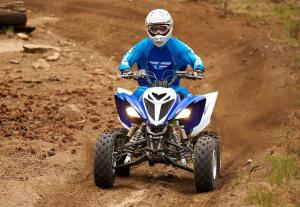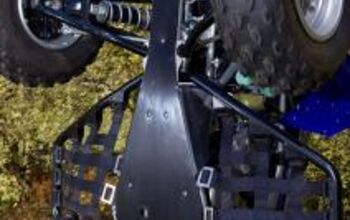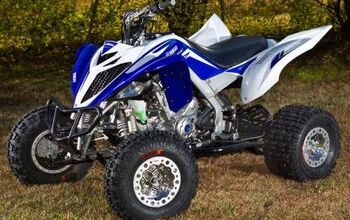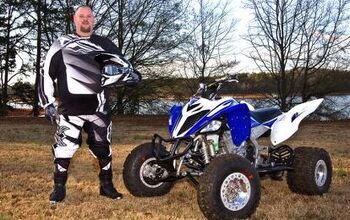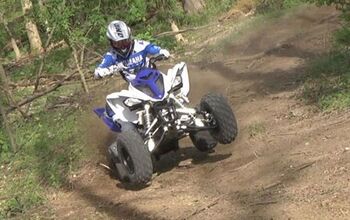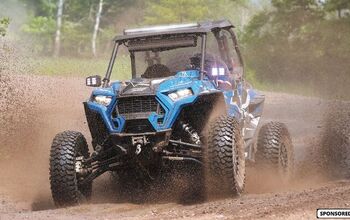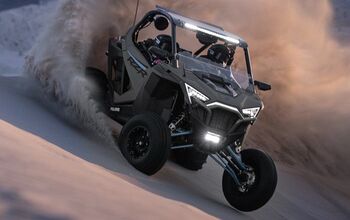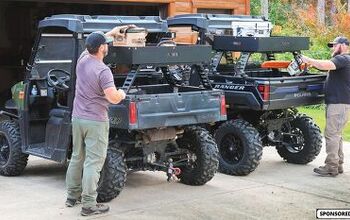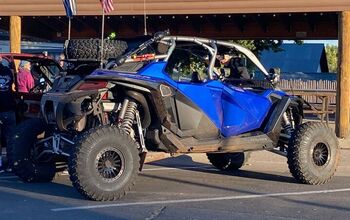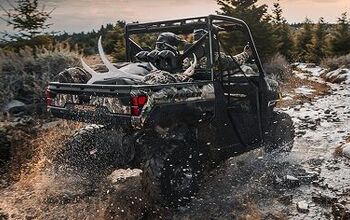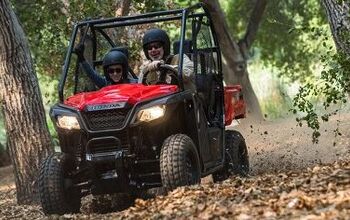2013 Yamaha Raptor 700 Review – Video
With the explosive growth of the UTV market in recent years and the still painful position of the Sport ATV segment, it has become increasingly difficult for manufacturers to continue producing these units, let alone improve upon existing models. We’ve seen manufacturers drop not just models, but complete lines of ATVs as much of the Sport ATV market has dried up or moved toward UTVs in recent years.
While everyone is experiencing the strain, Yamaha is one manufacturer that is fighting the trend and working tirelessly to maintain its position as the #1 brand of sport ATVs. Already boasting the largest line of sport ATVs on the market, Yamaha isn’t just sitting back and basking in its success.
Get the Flash Player to see this player.
We saw significant changes back in 2009 with the release of the YFZ450R by way of a new frame, fuel injection and a host of other upgrades, only to then improve upon the original YFZ450 in 2012 to offer a low cost, high performance option to the consumer.
Yamaha offers a whole family of Raptor 700 models for 2013 with price points designed to serve everybody.
Like the YFZ, the Yamaha Raptor received a major overhaul in 2006 which silenced critics and gave us the innovative and industry leading big bore ATV we have today. Well, most of it. But because Yamaha isn’t content to reach the top and just coast; it has set out to improve upon the machine even more for 2013.
WIN ATV.com’s 2013 Yamaha Raptor 700 Project
Before Yamaha starts making changes to a model, it does a great deal of market research and finds out exactly what the consumers want most out of that particular ATV.
Give Them What They Want
Yamaha’s research suggests that the average Raptor 700 owner is older had has different wants/needs than a YFZ450R owner.
With the largest line of Sport ATVs in the business, Yamaha has something for just about everyone so narrowing down your choice to what best suits your needs becomes the next issue. Yamaha already has a high performance, race ready sport ATV in the YFZ450R and its research suggests the demographics as well as key features sought by the Raptor crowd are a bit different than the fans of the YFZ.
For starters the typical YFZ user is younger and more interested in performance. Racing technology and fuel injection win out over price and model reputation as these users are more prone to make modifications that suit their needs and riding styles. They’re willing to sacrifice a bit of rider comfort if it means a better performing machine.
Fans of the Raptor are usually a bit older (late thirties) and have significantly more riding experience. These users are typically interested in a machine’s reliability, reputation and price over high performance. That is not meant to say in any way that Raptor users don’t like speed or great handling, it simply implies the different value these users consider when deciding which model suits their preferences and riding styles the best.
Yamaha takes all of this and much more information into account when it begins making changes to a machine and the result is its best attempt at meeting the demands of the consumer.
What’s New?
With reputation and price leading the way for a good many Raptor users, for 2013 Yamaha set out to maintain the quality and performance that has made the Raptor the top selling Sport ATV while lowering the price to make it more affordable.
The base model 2013 Yamaha Raptor 700 is offered in two color schemes and lacks the piggyback front shocks found on the other Raptor 700 models.
The result is three different models; the 700 ($7,699), 700R ($8,099) and 700R SE ($8,799), each with new features and every one with a lower price tag than the year before.
For starters you’ll notice immediately that the 2013 Raptor has a new, aggressive look to it. Engineers changed not only the look of the front plastics but also the position of the front fenders, moving them about 50mm forward to improve rider comfort. All three models also come standard with the same dual piston rear brake caliper as the YFZ450, a new addition for 2013.
2013 Yamaha Raptor 700R
Another great improvement to all three models is the addition of Maxxis tires. The new rubber was designed specifically for Yamaha and provides increased traction while still enabling you to break the rear end loose and slide around turns.
Because the Raptor is already an industry leading and best selling Sport ATV, Yamaha decided to retain the use of its innovative frame design which mates a steel front frame with a cast aluminum rear and subframe. This combination provides the right combination of rigidity and flex to make sure you don’t feel like you’re riding a board. There were also no changes to the 686cc engine as it has proven itself a dependable and worthy competitor in the big bore Sport ATV class.
2013 Yamaha Raptor 700R SE
In terms of cost cutting, this is where Yamaha started getting specific with each of the individual models. To begin with, Yamaha completely did away with the digital meter on all three Raptor 700 quads. While this is a nice feature, it falls more in the luxury category and has next to nothing to do with performance. Yamaha found it could cut the cost on each machine by doing away with it so the digital meter had to go bye-bye.
All of the 2013 Raptor 700 models receive aggressive new front styling.
For the standard 700 model, Yamaha opted to use a non-piggyback front shock to help shave more off the price tag. While these shocks offer no compression or rebound adjustability, they still allow you some preload adjustment and work well under a variety of conditions. The 700 also uses a solid front brake lever as opposed to the adjustable one found on last year’s model. Yamaha found that by making these simple changes it could drop the price by nearly $700. The Raptor 700 is available with two graphic schemes; a more edgy skull pattern and a very American red, white and blue pattern commemorating Yamaha’s new assembled-in-the-USA movement. The Raptor now joins the Grizzly 4×4 and the complete line of side-by-sides as the first Sport ATV from Yamaha to be assembled entirely in the United States.
The 700R and 700SE models are virtually identical to each other with the exception of a few extra goodies on the SE. Both retained the fully adjustable piggyback front shocks as well as the adjustable front brake lever. Yamaha did away with the wave rear brake rotor on the SE, which retains the use of the GYTR grab bar and heel guards.
The Ride
We tested the 2013 Raptor 700 in central Oregon’s high desert. The East Fort Rock OHV area boasts over 300 miles of trails, elevation reaching up to 6,400 feet and terrain ranging from desert or Baja-like conditions to tight and winding trails.
The Raptor 700R is a comfortable, powerful machine at home in the dunes and the trails.
One of our riders had ridden the area before and was a little skeptical about testing a big bore ATV in an area known for its tight and wooded trails; however, all doubts vanished just about as quickly as he took off down the trail. As it turns out, the Raptor 700 is quite at home on the trails and the big bore power was manageable as well usable everywhere we went. It feels very much like you’re riding a slightly heavier 450. With the extra horsepower of the big bore engine, the added weight is almost unnoticeable.
The Raptor 700R’s smooth power delivery gets you moving well in any gear.
One thing that makes the Raptor such a great trail machine is that you could simply select one gear and go. The power is smooth and consistent and you can lug the machine or feather the clutch a little if you happen to let the RPMs drop. At one point we actually started from a dead stop in third gear and the Raptor pulled itself right up to speed.
If you happen like to stay on the gas and in the higher RPMs, you won’t have any problem shifting. The transmission is smooth and clutch pull is a synch. We actually rode with just one finger on the lever most of the day.
This particular trail system gave us a great opportunity to test out the brakes as seemingly every straightway ended with a sharp turn that darted back into the woods with little to no warning. The dual piston calipers up front and the addition of the new dual piston in the rear made braking effortless. Even the few times we managed to hit fifth gear we were able to slow down in a hurry without ever losing control or having to mash the brakes.
Choosing to go with Maxxis tires was a boon to the Raptor’s handling.
We were quite impressed with the Maxxis tires. Not what you’d expect from stock tires, they performed incredibly well and provided excellent traction despite our somewhat harsh conditions. Oh yeah, we failed to mention that it began snowing not long after our arrival to the ride site. Though it made riding a bit uncomfortable, it allowed us to test the tires in a variety of conditions from powdery, dry dust to mud and everything in between.
Rider comfort was great and taller riders will feel very much at home on the Raptor 700. Standing at 6’ 2” we often feel cramped on 450 models, but the Raptor was quite comfortable. This was due in part to the new fender placement.
We tested the 700R version, which retained the use of the piggyback fully adjustable front shocks. The suspension performed well through whoops and rocks and soaked up the smaller stuff on those rare occasions when we could really open it up.
Our overall impression is that Yamaha has successfully done what so few can; improve upon an already excellent ATV, all while making it more affordable in an unstable and ever changing economic climate. The Raptor remains a dominating force in the Sport ATV category. The light handling makes it great for the trails and the big bore engine ensures you’ll have enough power to get anywhere you need to go.
No matter which Raptor 700 model you choose, squeezing the throttle and hitting the trails is always a good time.
We feel the price point cannot be emphasized enough as Yamaha has worked tirelessly to maintain the level of performance while saving the end user money. By making a few changes and offering three different models to accommodate different needs and budgets, Yamaha is able to offer a big bore ATV to a wider range of users.
If you happen to be one of those that feels performance should never be sacrificed for the sake of price, Yamaha has over 100 GYTR (Genuine Yamaha Racing Technology) accessories to help you increase performance or merely add some bling. Check out the full line of GYTR accessories as well as the new 2013 Yamaha Raptor 700, 700R and 700R SE at Yamaha-Motor.com.
Related Reading
Growing up in Oregon, most of Seth's involvement in the powersports world was limited to what he saw in magazines and videos. Following a brief stint in the corporate world, Seth took a flying leap (literally) and moved to California to pursue a career in freestyle motocross. Though short lived, the opportunity immersed him in the industry and is now a well-established off-road writer.
More by Seth Fargher




